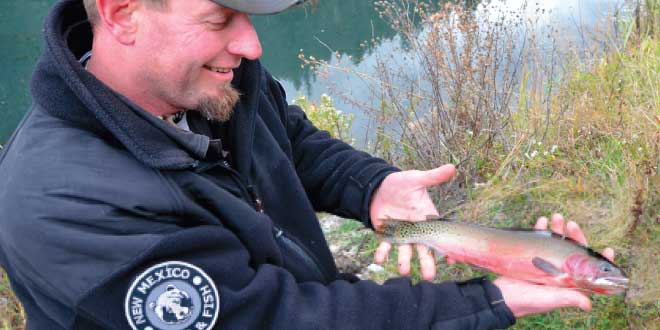Have you ever wondered why Rio Grande cutthroat trout conservation is important? Rio Grande cutthroat trout are not only New Mexico’s state fish, they are also native only to northern New Mexico and southern Colorado.
The presence and abundance of native trout on the landscape helps maintain a healthy and balanced ecosystem. Rio Grande cutthroat trout provide a unique angling experience and are popular with anglers. Department survey data suggests that approximately 30 percent of New Mexico anglers prefer Rio Grande cutthroat trout (RGCT) over other cold-water species.
Rio Grande cutthroat trout occupy abaout 450 miles of stream in New Mexico. The species, Oncorhynchus clarkii virginalis, is the southernmost occurring subspecies of cutthroat trout.
The Department raises Rio Grande cutthroat trout exclusively at Seven Springs Hatchery, and for good reason, said Tony Jacobson, hatchery manager at Seven Springs. Broodstock kept at Seven Springs are genetically pure cutthroat trout sourced from wild populations.
“Primarily, our main focus is on recovery of the species,” said Jacobson. “They’re going into areas where all of the nonnative trout have been removed. In a lot of cases barriers have been put in place to prevent the nonnatives from getting back in there. We don’t want to raise a rainbow trout alongside a cutthroat in case there’s some mixing… you would just lose a lot of work in one restocking event.”
Raising wild fish at hatcheries takes special care, Jacobson said. The growth rate of Rio Grande cutthroat is slow when compared to rainbow trout. The hatcheries source water, from deep springs, remains at a constant 48 degrees year-round.
Anytime you’re working with wild strains of native stocks of fish there are unique challenges.
“A lot of the fish raised in hatcheries today are from domesticated strains,” he said. “They might be triploids (three sets of chromosomes), for example. Our hatchery populations are all wild strains, some first generation in hatchery straight out of the stream.”
Fish raised from wild strains tend not to tolerate real high densities that domesticated fish could, he explained. The hatchery raises cutthroat at low densities to ensure their survival and best obtainable health.
The Department releases an average of 300,000 cutthroat—mostly small fry—per year, Jacobson noted. About 10,000 cutthroat trout will be stocked in the Rio Grande later this year during the Department’s annual Rio Grande gorge stocking event.
 New Mexico Wildlife magazine Conserving New Mexico's Wildlife for Future Generations
New Mexico Wildlife magazine Conserving New Mexico's Wildlife for Future Generations
